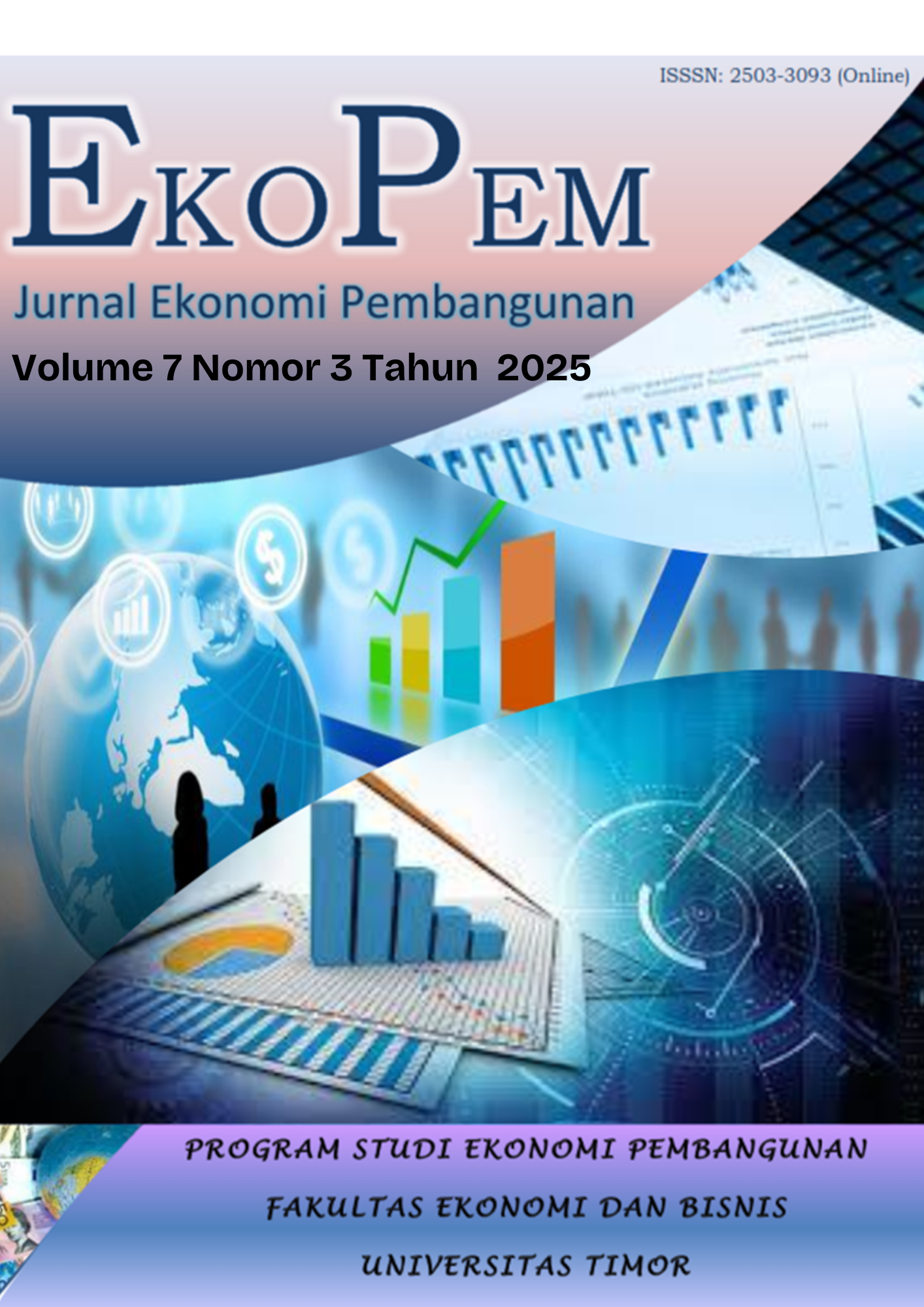Pekerja Sektor Informal Sebagai Determinan Jebakan Kemiskinan di Nusa Tenggara Timur
DOI:
https://doi.org/10.32938/jep.v7i3.10320Keywords:
Informal Sector Workers, Informal Sector Wages, Poverty Trap, NTTAbstract
Penelitian ini bertujuan untuk menganalisis pengaruh jumlah pekerja sektor informal dan upah pekerja sektor informal terhadap tingkat kemiskinan di Provinsi Nusa Tenggara Timur (NTT). Metode yang diterapkan dalam penelitian ini merupakan pendekatan kuantitatif dengan model analisis regresi linier berganda, dengan data sekunder pada tahun 2023 bersumber dari Badan Pusat Statistik. Hasil analisis menunjukkan bahwa jumlah pekerja sektor informal berpengaruh positif dan signifikan terhadap kemiskinan, mengindikasikan bahwa semakin banyak masyarakat yang bekerja di sektor informal, semakin tinggi tingkat kemiskinan yang terjadi. Hal ini mencerminkan kondisi "jebakan kemiskinan" di mana pekerja informal cenderung berpendapatan rendah, tidak tetap, dan tanpa jaminan sosial. Sementara itu, variabel upah pekerja sektor informal menunjukkan pengaruh negatif namun tidak signifikan terhadap kemiskinan. Artinya, kenaikan upah belum mampu secara nyata menurunkan tingkat kemiskinan tanpa adanya peningkatan produktivitas dan perlindungan sosial. Oleh karena itu, diperlukan intervensi kebijakan melalui pelatihan keterampilan, akses permodalan, legalisasi usaha mikro, serta jaminan sosial bagi pekerja sektor informal untuk secara efektif menekan angka kemiskinan di NTT.
References
Bacchetta, M., Ernst, E., & Bustamante, J. P. (2009). Globalization and informal jobs in developing countries. International Labour Organization Geneva. https://www.wto.org/english/res_e/booksp_e/jobs_devel_countries_e.pdf
Becker, G. S. (1964). Human capital: a theoretical and empirical analysis, with special reference to education (Vol. 3). University of Chicago Press Chicago.
Chen, M. (2007). Rethinking the Informal Economy: Linkages with the Formal Economy and the Formal Regulatory Environment. United Nations, Department of Economics and Social Affairs. https://econpapers.repec.org/RePEc:une:wpaper:46
Chen, M., Grapsa, E., Ismail, G., Rogan, M., Valdivia, M., Alfers, L., Harvey, J., Ogando, A. C., Reed, S. O., & Roever, S. (2021). COVID-19 and informal work: Distinct pathways of impact and recovery in 11 cities around the world. WIEGO: Manchester, UK. https://hdl.handle.net/20.500.12413/16769
Fields, G. (2019). Employment and development: How work can lead from and into poverty. Oxford University Press.
Fields, G. S. (1990). Labour market modelling and the urban informal sector: Theory and evidence. https://ecommons.cornell.edu/server/api/core/bitstreams/67086a38-fef6-419f-8489-b4cd0db8c227/content
Günther, I., & Launov, A. (2012). Informal employment in developing countries: Opportunity or last resort? Journal of Development Economics, 97(1), 88–98. https://doi.org/10.1016/j.jdeveco.2011.01.001
Hart, K. (1973). Informal income opportunities and urban employment in Ghana. The Journal of Modern African Studies, 11(1), 61–89. https://doi.org/10.1017/S0022278X00008089
Hidayah, U., Klau, A. D., & Prima, S. R. (2022). Typology and spatial distributions of rural poverty: Evidence from Trenggalek Regency, Indonesia. Journal of Socioeconomics and Development, 5(1), 88. https://doi.org/10.31328/jsed.v5i1.3256 Hill, M. S. (1985). The changing nature of poverty. The ANNALS of the American Academy of Political and Social Science, 479(1), 31–47. https://doi.org/10.1177/0002716285479001003
ILO. (1973). Employment, incomes and equality: A strategy for increasing productive employment in Kenya: Geneva: ILO, 1972. Pp. xx+ 600.[UK pound] 3.96. World Development, 1(6), 78–80. https://econpapers.repec.org/RePEc:eee:wdevel:v:1:y:1973:i:6:p:78-80
Lewis, W. A. (1954). Economic development with unlimited supplies of labour. https://la.utexas.edu/users/hcleaver/368/368lewistable.pdf
Loayza, N. V, & Rigolini, J. (2011). Informal employment: safety net or growth engine? World Development, 39(9), 1503–1515. https://doi.org/10.1016/j.worlddev.2011.02.003
Mahenra, T., & Juardi, J. (2024). Dampak Tingkat Pengangguran, Kesempatan Kerja, Upah Minimum, dan Inflasi terhadap Kemiskinan di Kota Makassar. Bulletin of Economic Studies (BEST), 4(1), 58–72. https://doi.org/10.24252/best.v4i1.47533
Maloney, W. F. (2004). Informality revisited. World Development, 32(7), 1159–1178. https://doi.org/10.1016/j.worlddev.2004.01.008
Nariswari, R. (2020). Analisis Peranan Sektor Informal terhadap Kemiskinan di Jawa Timur. Jurnal Ilmiah Mahasiswa FEB, 9(1), 1–14. https://jimfeb.ub.ac.id/index.php/jimfeb/article/view/6986
North, D. C. (1990). Institutions, institutional change and economic performance. Cambridge University. http://edu.gber.ge/uploads/files_66_1.pdf
Nurkse, R. (1953). Problems of capital formation in underdeveloped countries. (No Title).
Sachs, J. (2005). The end of poverty Penguin Books. New York.
Sibagariang, F. A., Mauboy, L. M., Erviana, R., & Kartiasih, F. (2023). Gambaran pekerja informal dan faktor-faktor yang memengaruhinya di Indonesia tahun 2022. Seminar Nasional Official Statistics, 2023(1), 151–160. https://doi.org/10.34123/semnasoffstat.v2023i1.1892
Simbolo, C. M., Nisa, F., Pinem, H. A., Alwi, H., Purnomo, D., Rinaldi, M., & Rozaini, N. (2023). ANALISIS PENGARUH MODAL MANUSIA DAN UPAH MINIMUM TERHADAP KEMISKINAN DI INDONESIA. Journal of Social and Economics Research, 5(2), 213–226. https://doi.org/10.54783/jser.v5i2.124
Sukesi, K. (2015). Gender dan Kemiskinan di Indonesia. Universitas Brawijaya Press.
Taufiq, N., & Dartanto, T. (2020). Education, Informal Turnover and Poverty Dynamics in Indonesia. International Journal of Economics & Management, 14(1). https://scholar.ui.ac.id/en/publications/education-informal-turnover-and-poverty-dynamics-in-indonesia
Todaro, M. P. ., & Smith, S. C. . (2020). Economic development. Pearson.
Tokman, V. E. (1979). An exploration into the nature of informal—formal sector relationships. In The Urban Informal Sector (pp. 1065–1075). Elsevier. https://doi.org/10.1016/B978-0-08-024270-5.50007-7
Williams, C. C., & Nadin, S. J. (2012). Tackling entrepreneurship in the informal economy: evaluating the policy options. Journal of Entrepreneurship and Public Policy, 1(2), 111–124. https://doi.org/10.1108/20452101211261408
Downloads
Published
Issue
Section
License
Copyright (c) 2025 Ekopem: Jurnal Ekonomi Pembangunan

This work is licensed under a Creative Commons Attribution-NonCommercial-ShareAlike 4.0 International License.



2.png)












